|
Adobe's color saturation feature as a tool to investigate passenger pigeon sightings
by Pam Rotella
6 Decmber 2016, last updated 10 December 2016
HoriconBirds.com
NOTE: This article is in progress and will be revised.
Most people who see a living passenger pigeon, even regular birders, tell me that at first they wonder what it is. It looks like a big gray mourning dove, but not quite... Then they manage to locate passenger pigeon photos online, and find that the bird is supposedly extinct.
Proving a living passenger pigeon sighting will probably start with a photographer or videographer who happens to have a decent camera and lens for wildlife photography with him or her... and it did almost happen. When I first encountered a living passenger pigeon, I had my usual camera with a long lens in the car, but loud engine noise from the car behind me scared the bird off before I could pull over and lift my camera.
Thankfully, in the case of the latest sighting, "Joe G." was able to take several good photos of the bird(s), and has granted me permission to post them here. The bird does in fact look like a gray pigeon or dove with a reddish tummy, and enhancing the photos only seems to prove it. To follow is one of Joe G.'s passenger pigeon photos, cropped for size but not enhanced...
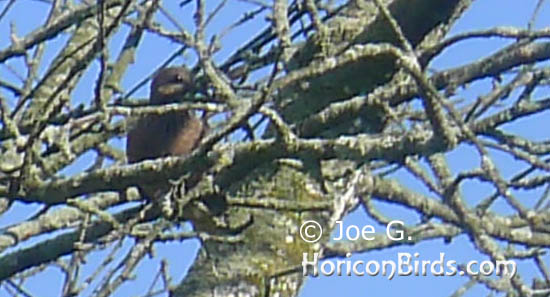
|
|
Passenger pigeon picture #4 by Joe G., enlarged (cropped) but not otherwise enhanced.
|
The above photo is probably the clearest shot Joe G. was able to take before the bird left the area. Obviously, the photo is a little drab, and it comes from an enlargement. While the bird does appear to have the characteristics of a passenger pigeon, frankly I'd like a better picture, maybe something with better color. Adobe Photoshop and Photoshop Elements software give photographers editing features to enhance photos, and I decided to investigate the bird(s) in Joe G.'s pictures with both standard Adobe auto-adjustments, and with high color saturation.
I've posted this and Joe's other photos with enhancements on another page for people to see, using both Adobe's auto-correction features and the color saturation feature to enhance the birds' colors. In this article, I'll show examples of color saturation, to help readers understand how it works, and how to interpret the results. To follow is the photo of the bird above, with Adobe color saturation boosted about 50%:
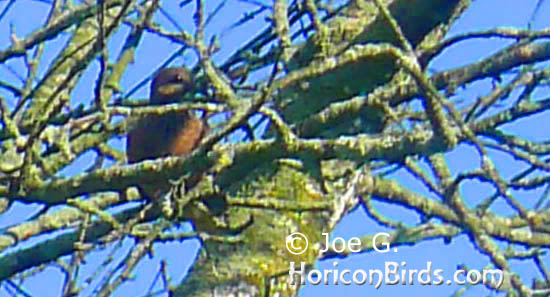
|
|
Passenger pigeon picture #4 by Joe G., with saturation boosted about 50%.
|
In this photo, I used Adobe's saturation feature as an investigative tool, to look for any colors the software found. The saturation level used here is probably at or above what a photographer would use to brighten up a drab picture in everyday photo editing. Notice that the tree trunk is a little greener, the bird's orange tummy is a bit brighter, and the bird's eye may have a reddish hue becoming more apparent.
Boosting color saturation reduces neutral tones like gray, and exaggerates color pixels. Used in moderation, increasing saturation can make a drab picture look like it was taken in bright sunlight, and decreasing saturation can change a color photo into black and white. Boosting saturation to maximum limits can exaggerate color so much that the picture looks like a cartoon. To follow is the same image with Adobe's color saturation at the maximum level:
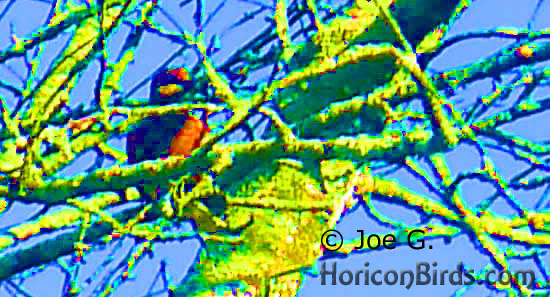
|
|
Passenger pigeon picture #4 by Joe G., with maximum Adobe color saturation.
|
In this photo, Adobe's saturation feature is used as a type of investigative tool, to find and exaggerate or confirm colors not obvious in the original. Passenger pigeons often look similar to mourning doves, which are brown birds with black eyes. Female passenger pigeons can be brownish birds according to the historical record, and so may be harder to differentiate from mourning doves, but male passenger pigeons are gray birds with reddish breasts and red eyes and feet.
For the photo above, I boosted saturation well beyond the level a photographer would normally use to enhance a photo. In this case, colors become brighter and pixels are exaggerated, breaking out of their normal boundaries. You can see this happening with the moss on the tree, which is brighter and covering a larger area than in the original photo.
If this bird had been a mourning dove, I'd expect brown tones to change more toward yellow and less toward gray, and its eyes to stay dark. Instead, in the bird above the body stayed gray, the breast became a brighter shade of orange, and red pixels were found around its eyes. That color pattern is consistent with a passenger pigeon, and not a mourning dove.
Also notice that when increasing saturation in gray areas or shadows, the gray will often break into other colors sometimes found in shadows, like blue or violet.
I'm sure my readers are wondering how reliable colors found with Adobe's saturation may be. The software may seem reasonable to color a tree trunk green when we can see green moss there, but what about changing a dark eye into a red one? Can we trust the software on all of these colors?
I'll try to demonstrate how Adobe's saturation works with photos I already have – drab and overexposed photos that a photographer may use the "Saturation" feature to enhance under normal circumstances, and then mourning dove photos, to demonstrate whether the saturation feature could have mistakenly made a mourning dove appear to be a passenger pigeon.
To be clear, I won't be discussing how to use Adobe's "Saturation" feature in this article. There are plenty of tutorials online for that. What I find lacking are demonstrations of what the feature actually does, how it works. A few pages on
Adobe's own web site help describe the saturation feature, for example Adobe defines saturation as:
"Saturation Creates a result color with the luminance and hue of the base color and the saturation of the blend color. Painting with this mode in an area with no (0) saturation (gray) causes no change."
Another website describes saturation as:
"Saturation is the "purity" of the color, also known as "chromaticity," especially in TV and video work. A yellow that can't get any yellower is fully saturated. To desaturate a color you add grey (or you subtract color leaving grey behind -- pick whichever description seems more intuitive)."
First, I'll demonstrate how Adobe's saturation feature is typically used by photographers. To follow is an overexposed photo of pageant winners from Fort Wayne, Indiana. Saturation is often used by photographers specifically on overexposed photos:
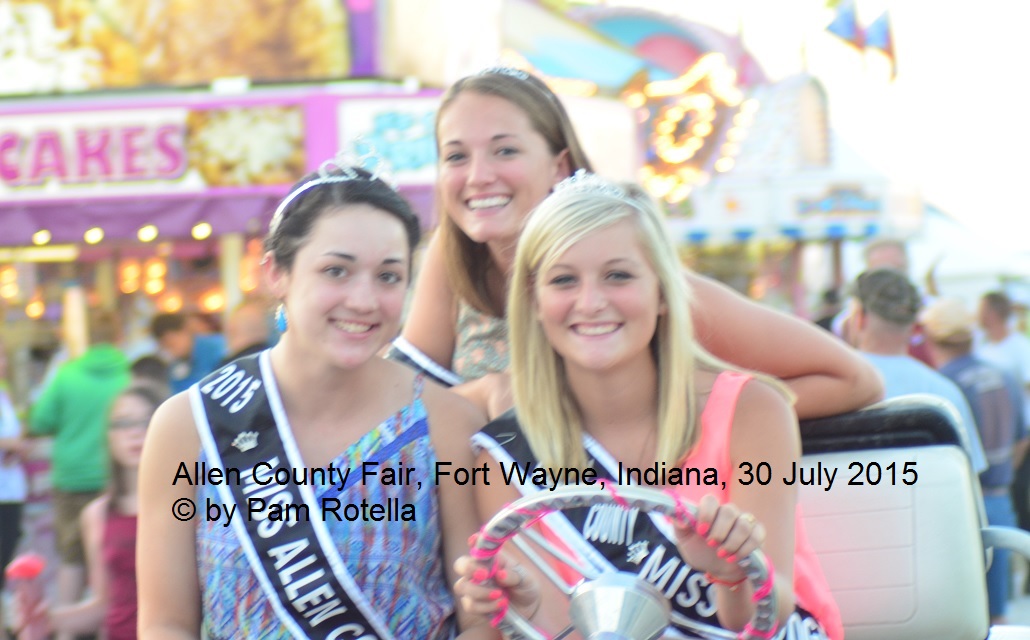
|
|
Overexposed photo of Indiana pageant winners at the Allen County Fair near Fort Wayne, Indiana, as posted on Twitter. This photo was cropped and labeled but otherwise not enhanced or corrected. Photo by Pam Rotella.
|
Obviously, this picture is overexposed, and the circumstances surrounding the picture explain why. I was walking along at Allen County Fair last year, occasionally taking pictures of things that interested me, when I saw a cart with local pageant winners driving toward me. I raised my camera to take their picture, and they were kind enough to stop for a few seconds and pose for me. Unfortunately, I had no idea what settings were on my camera at the time, and I didn't have time to make adjustments. I quickly snapped a few pictures, hoping that at least one would turn out, and they drove off.
Unfortunately, the photos were overexposed. This picture looks washed out, and the women look anemic.
One way to correct overexposure is to enhance the picture with Adobe's auto-adjust features, which I used on the same picture...
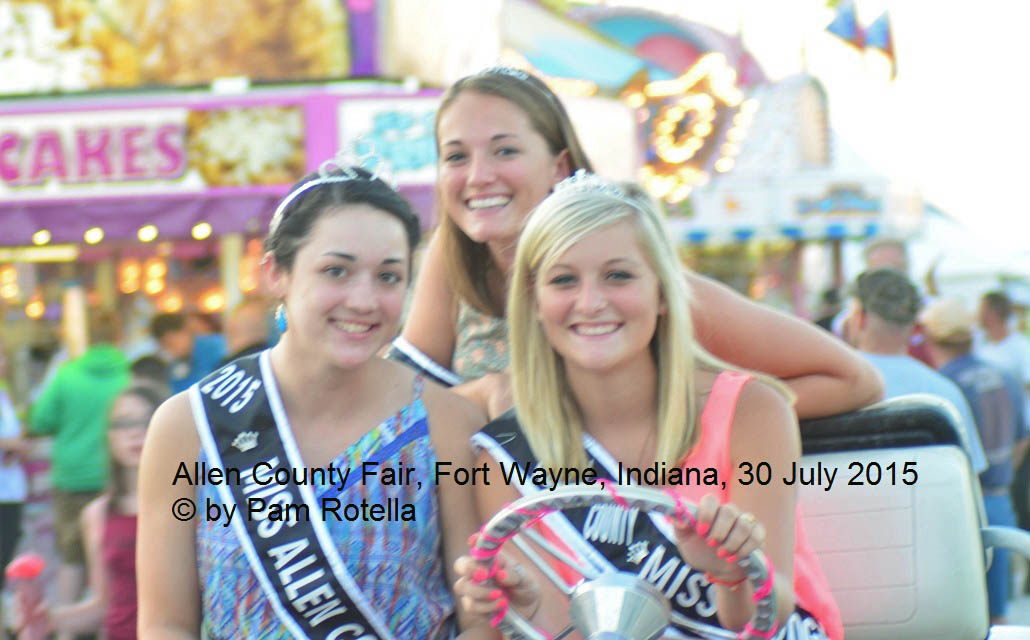
|
|
Photo of Indiana pageant winners with auto-corrections by Adobe applied: 1.) "Smart Fix," 2.) Lighting/Levels, 3.) Lighting/Contrast, and 4.) Color. Photo by Pam Rotella
|
I used Adobe's Smart Fix, Lighting Levels, Lighting Contrast, and Color auto-adjustments on the picture above. And while it looks a little better, the colors are still washed out.
This would be a good situation for boosting saturation, as in the following image:
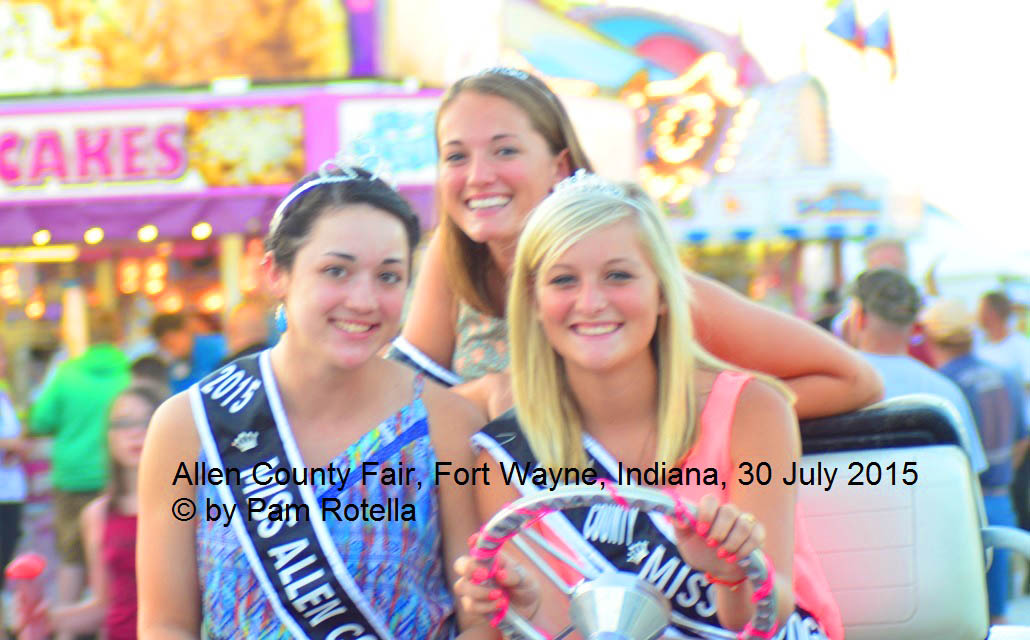
|
|
Indiana pageant winners with saturation boosted. Photo by Pam Rotella
|
This photo was not enhanced with any feature other than saturation, and I've boosted its saturation to the upper end of what a photographer would typically use. The colors are close to what I saw in person. Saturation can be a good way of rescuing photos that are overexposed or too drab for other reasons.
However, saturation can be overdone, boosted to levels that make the subjects look cartoonish. For standard photography, that's bad. But for investigating passenger pigeons to see what we can find... good. Below is the same picture boosted beyond normally acceptable levels of saturation.
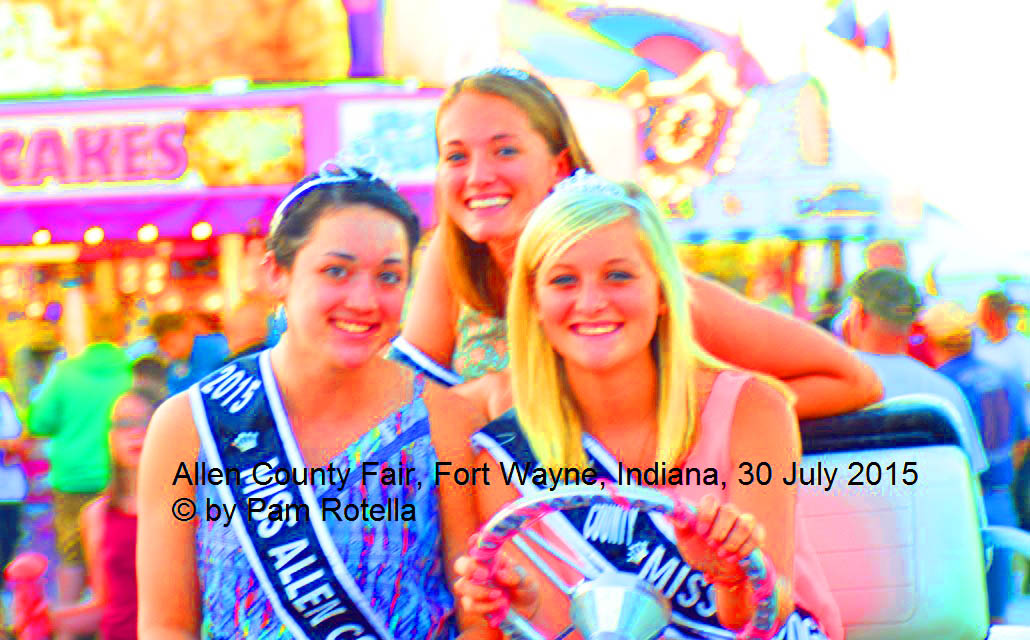
|
|
Saturation can be overdone, as seen in this cartoonish picture. Photo by Pam Rotella
|
Notice the shadows turning blue in the photo above, even in their eyes and the driver's hair, which could be reflecting a blue object somewhere. The white seat behind the driver now looks pink, and revisiting the original photo shows a slight pink reflection from the driver's pink shirt, and also a bluish tint to the rest of it. The saturation feature will pick up these colors and exaggerate them. Increasing saturation is a good way to find colors that aren't easily noticed.
Saturation is also used to rescue drab pictures, for example wildlife photography taken on an overcast day. Many photos that have vivid colors, as though they were taken in direct sunlight, are simply corrected and saturated after the fact. I had to search my portfolio for a while to find overexposed bird photos, especially gray birds, but I managed to find a grey crowned crane at the International Crane Foundation in Baraboo, Wisconsin, apparently taken on a drab day.
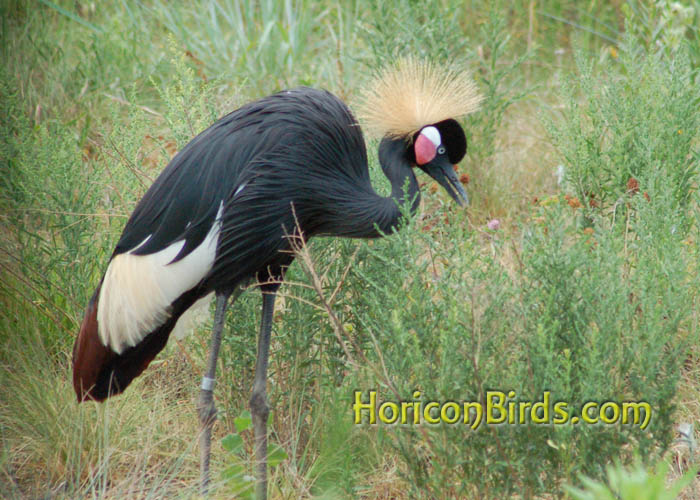
|
|
This photo of a gray crowned crane was cropped for size but wasn't otherwise adjusted. Photo by Pam Rotella
|
The photo above wasn't adjusted other than cropping and sizing for posting online -- there are no color corrections from Adobe applied. Notice how drab the yellow feathers on the crane's head look. Even the grass is dull.
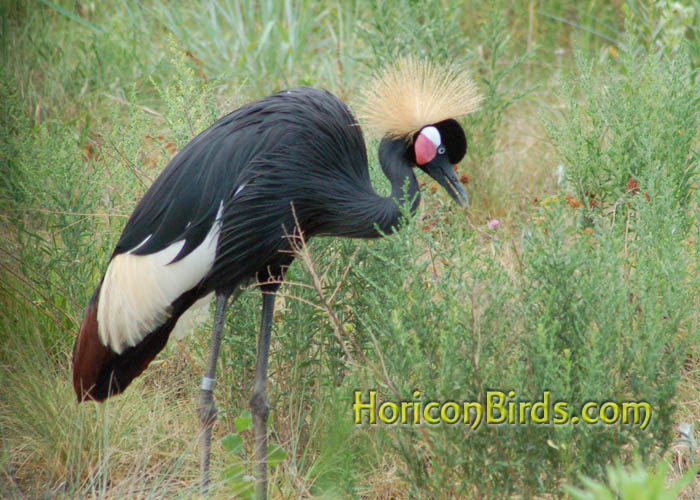
|
|
Grey Crowned Crane with Adobe auto-corrections applied. Photo by Pam Rotella
|
As with the pageant winners' photo earlier, I used Adobe's auto-correct features Smart Fix, Lighting/Levels, Lighting/Contrast, and Color on the picture above. Notice that it isn't much different than the original photo. It could use something extra.
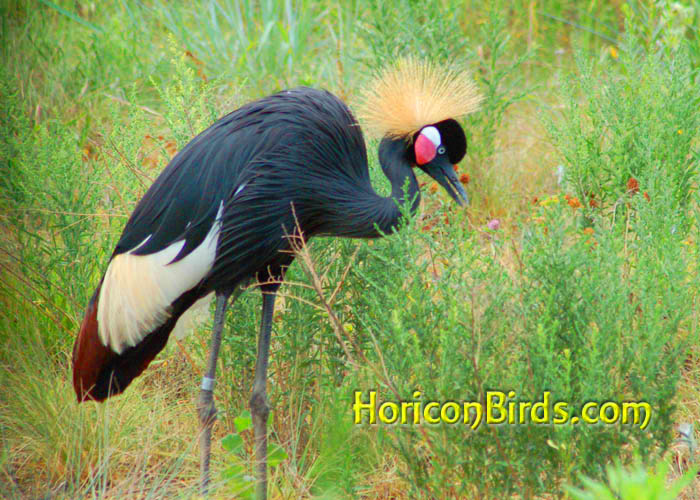
|
|
Grey Crowned Crane with Adobe Color Saturation boosted. Photo by Pam Rotella
|
The picture above has no enhancements other than boosting saturation. The bird's colors are richer and the grass is greener, with dried yellow grass and flower tops more easily discerned. Notice the HoriconBirds.com wording has become less opaque. Opacity was set to over 60% in the original photo. Saturation rescued this picture in a way that other enhancements did not. This is now a picture that a photographer could use.
In the next version of the same photograph, saturation is boosted to the maximum level:
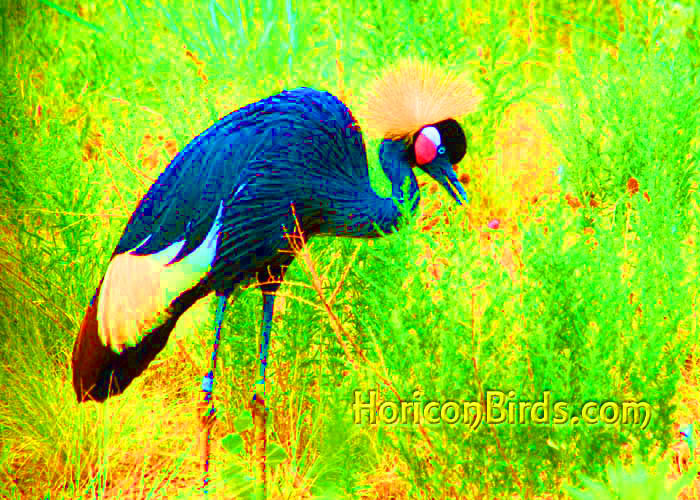
|
|
Grey Crowned Crane with maximum Adobe Color Saturation applied. Photo by Pam Rotella
|
Notice that blues and purples are brought out of the shadows, and colors in general are exaggerated. There are reddish markings on the crane's bill, although markings were visible on the bill in the original photo. But other than colors found in shadows, most colors are based on colors visible in the original photo. The bird's eye remains gray, its crown is yellow, the tail has brown and white on it.
We'll also use color saturation to rescue a drab photo of whooping cranes dancing at ICF in Baraboo. To follow is the original photo, cropped but not enhanced:
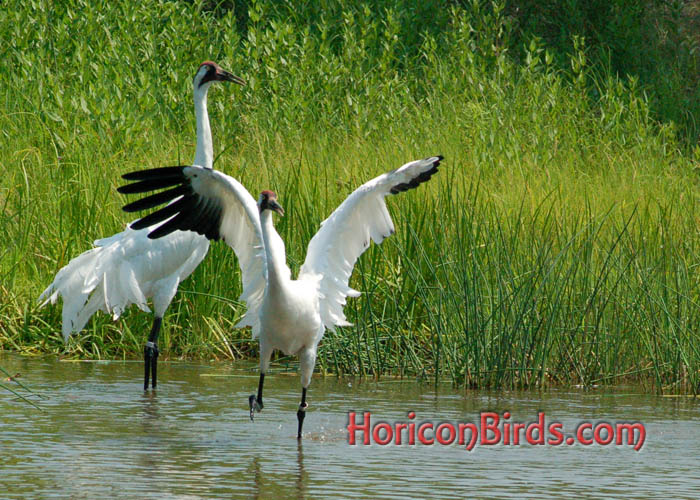
|
|
Whooping Cranes dancing at the International Crane Foundation in Baraboo, Wisconsin. This photo was cropped but not enhanced or corrected. Photo by Pam Rotella
|
Although whooping cranes are white birds, the skin on the top of their heads should be red, their eyes should be yellow, and the grass behind them should be green. All of those colors are present, but look dull in the previous picture.
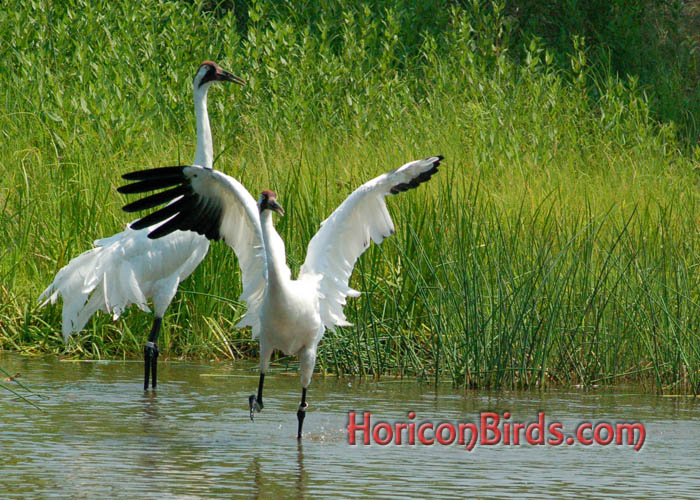
|
|
Adobe auto-corrections applied to image of whooping cranes dancing in their enclosure at the International Crane Foundation in Baraboo, Wisconsin. Photo by Pam Rotella
|
The same four Adobe auto-corrections that I used with previous photos were applied to the above photograph: Smart Fix, Lighting Levels, Lighting Contrast, and Color auto-adjustments. Yet this photo looks much like the original. And so this photo is a good candidate for boosting saturation, as was done in the following image:
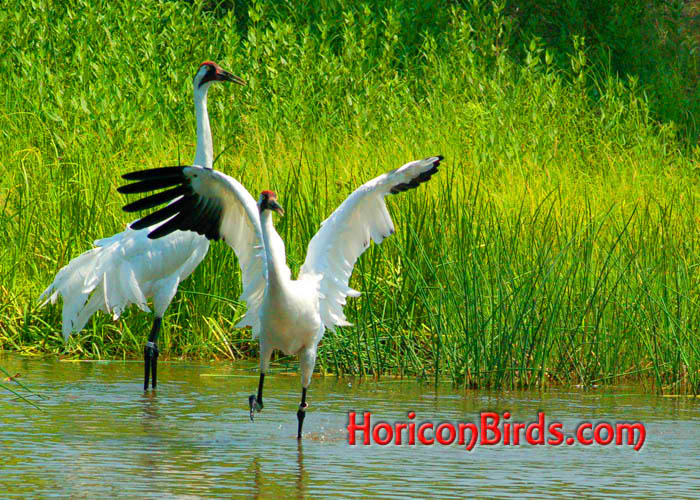
|
|
Saturation boosted on picture of dancing Whooping Cranes. Photo by Pam Rotella
|
In the picture above, I added no enhancements or corrections other than boosting color saturation to a level that a photographer may use. The top of the cranes' heads are vivid red, the grass is bright green, and the water is reflecting the blue sky and green grass. This photo could probably use some exposure adjustment due to shadows from the bright sun, but is otherwise ready to go.
But how would the colors change if saturation were boosted to the maximum level?
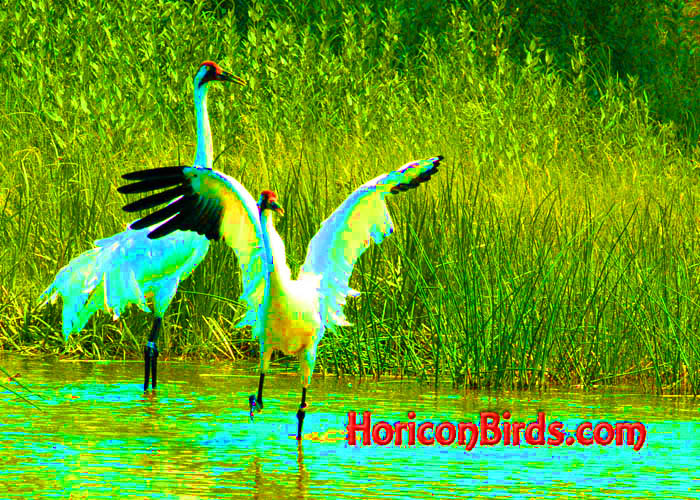
|
|
Maximum saturation added to photo of Whooping Cranes dancing at ICF. Photo by Pam Rotella
|
Again I've boosted the color saturation to its maximum level in the dancing cranes picture above. Although the yellow and blue shadowing may seem odd, there are clearly hints of those colors on the original photo, probably from the water reflecting its own color onto the birds. The dark blotches on the birds are also visible as dark areas on the original photo with accent colors replacing the black that was removed.
While this photo isn't usable, other than in a demonstration of Adobe's saturation feature, it does show that the saturation feature largely stays true to the colors in the original photo. It hasn't turned yellow eyes red, or a white tummy orange (although I've noticed that a certain type of monitor doesn't break the yellow, brown, green, and blue shadows on the bird's underside into separate colors, and may look like one brown or peachy blotch). The colors are exaggerated but basically the same.
When investigating pictures of passenger pigeons, it may also be helpful to examine the results of high saturation on mourning doves. Is it possible that the dove's black eyes shift toward the red spectrum when color saturation is boosted? Mourning doves normally have black eyes, from my experience as a wildlife photographer. From personal experience, if they shift toward any color, it's deep violet.
And so to start, I'll use a photo of a variety of mourning dove that has some gray on the back of its head and neck, and a breast with a rose-colored tint. This bird was found in Fort Wayne, Indiana, and is not enhanced other than cropping it to enlarge.
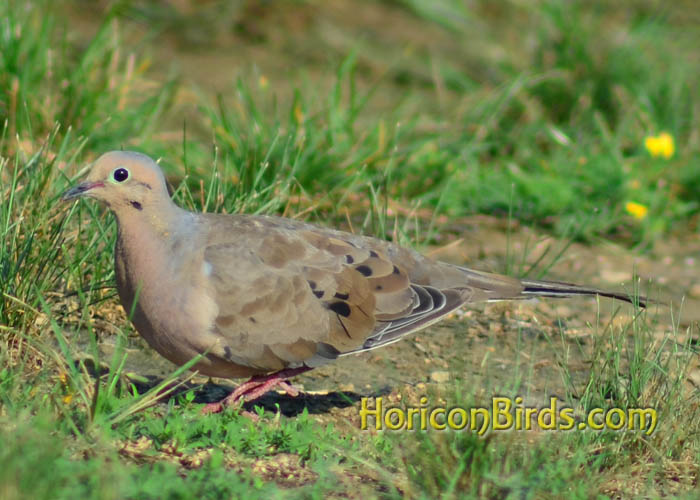
|
|
A mourning dove in Fort Wayne Indiana, photo cropped but not enhanced. Photo by Pam Rotella
|
Next, the same mourning dove with high color saturation, also cropped closer to the bird's face to show color detail. Notice that the eye remains black but trends toward violet, as do a few other markings on the bird. The blue eye rings, part of its normally black beak, and the gray area on its head and neck become blue when gray and black are reduced and colors are exaggerated by increasing saturation. The brown color of the bird becomes yellowish but notably does not become gray:
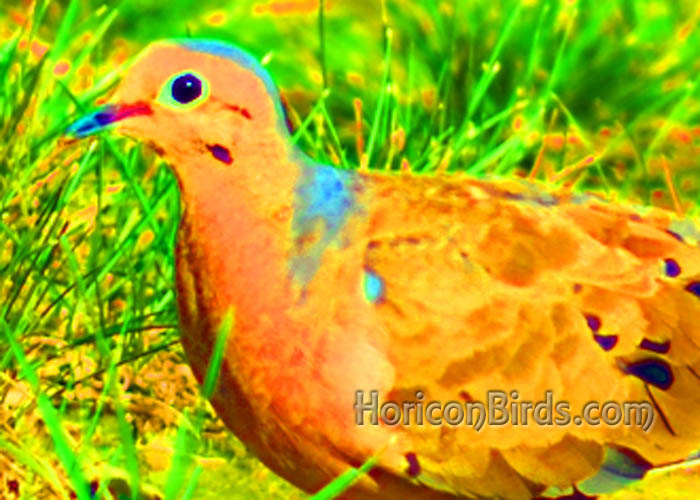
|
|
A mourning dove in Fort Wayne Indiana, photo enhanced with high color saturation. Photo by Pam Rotella
|
To follow is the image of a mourning dove photographed in reddish lighting, or with a camera exposure that was reddish. This bird was located at White River Marsh in Wisconsin:

|
|
A mourning dove at White River Marsh, Wisconsin, photo cropped but not enhanced. Photo by Pam Rotella
|
Next, the same photo has been enhanced with very high saturation. Notice that the eye appears to be dark red, but so do shadows all over the image, which could indicate that the photo has a reddish hue overall, possibly from environmental lighting. Also notice that the bird's natural brown color does not become gray, and its tummy does not become orange due to the high saturation:

|
|
A mourning dove at White River Marsh, Wisconsin, enhanced with high Adobe color saturation. Photo by Pam Rotella
|
How can a photographer investigate whether the red eye and eye ring are due to a lighting effect? One way is to check the series of pictures for a picture with a different hue. In this case, I found another picture of the same bird without the reddish lighting:
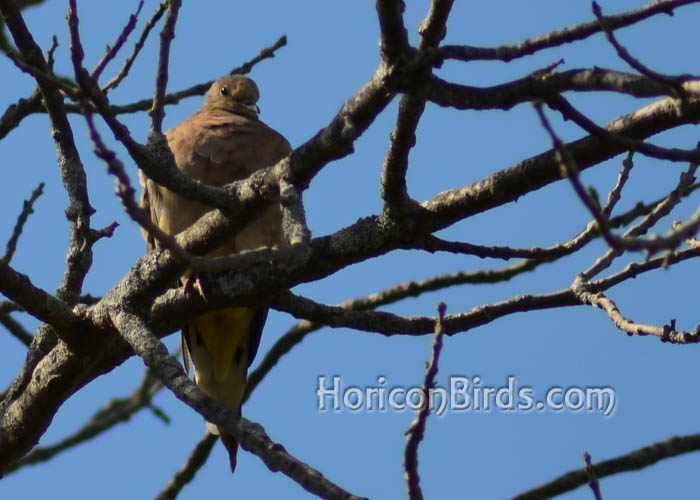
|
|
A different image of the same mourning dove pictured above, White River Marsh, Wisconsin, cropped but not enhanced. Photo by Pam Rotella
|
Notice that when saturation is boosted, the eye remains black, although the photo does have a reddish tint to some of its shadows. In both pictures of this bird, the overall color remains brown, again showing that increased saturation will not turn a mourning dove into a gray and reddish passenger pigeon:
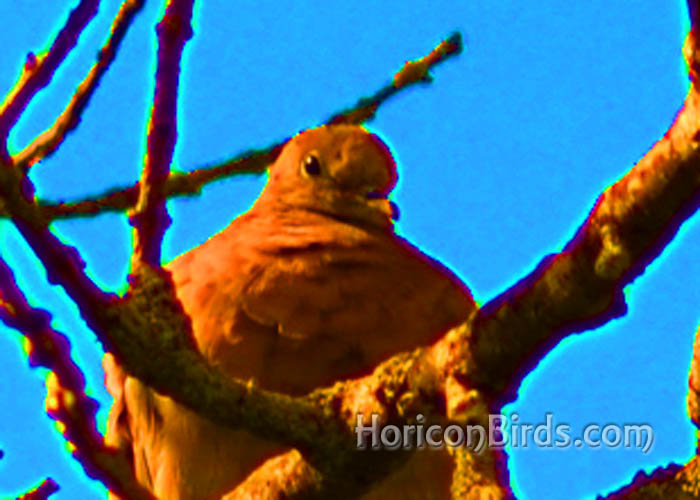
|
|
The mourning dove pictured above with high color saturation, White River Marsh, Wisconsin. Photo by Pam Rotella
|
Adobe saturation isn't typically used as an investigative tool to identify bird species, but the demonstration above has shown that maximizing color saturation will:
1.) Not turn a brown bird gray.
2.) Not change a bird's eye color.
3.) Exaggerate colors found, and sometimes increase the area where found.
4.) Bring out colors found in shadows, while reducing gray and black.
5.) Increase colors and reduce gray and black, including bringing out colors found in gray features like feathers.
Based on this demonstration, boosting color saturation in Joe's pictures do seem to confirm that the bird(s) he saw were not brown mourning doves, but rather gray birds in the dove or pigeon family with an orange breast and dark red eyes. All of this is consistent with passenger pigeons and not mourning doves.
Does this prove that Joe's pictures depict a living passenger pigeon?
My guess is that the picture quality isn't clear enough for everyone to agree on a species, even with color saturation. However, I think that the use of color saturation has confirmed his account of the sighting, and that it's probable the birds he photographed were living passenger pigeons.
All original content © 2016 by Pam Rotella, including photos taken by Pam Rotella. Photos by Joe G. © by Joe G.
|